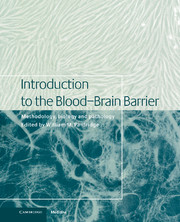Book contents
- Frontmatter
- Contents
- List of contributors
- 1 Blood–brain barrier methodology and biology
- Part I Methodology
- 2 The carotid artery single injection technique
- 3 Development of Brain Efflux Index (BEI) method and its application to the blood–brain barrier efflux transport study
- 4 In situ brain perfusion
- 5 Intravenous injection/pharmacokinetics
- 6 Isolated brain capillaries: an in vitro model of blood–brain barrier research
- 7 Isolation and behavior of plasma membrane vesicles made from cerebral capillary endothelial cells
- 8 Patch clamp techniques with isolated brain microvessel membranes
- 9 Tissue culture of brain endothelial cells – induction of blood–brain barrier properties by brain factors
- 10 Brain microvessel endothelial cell culture systems
- 11 Intracerebral microdialysis
- 12 Blood–brain barrier permeability measured with histochemistry
- 13 Measuring cerebral capillary permeability–surface area products by quantitative autoradiography
- 14 Measurement of blood–brain barrier in humans using indicator diffusion
- 15 Measurement of blood–brain permeability in humans with positron emission tomography
- 16 Magnetic resonance imaging of blood–brain barrier permeability
- 17 Molecular biology of brain capillaries
- Part II Transport biology
- Part III General aspects of CNS transport
- Part IV Signal transduction/biochemical aspects
- Part V Pathophysiology in disease states
- Index
4 - In situ brain perfusion
from Part I - Methodology
Published online by Cambridge University Press: 10 December 2009
- Frontmatter
- Contents
- List of contributors
- 1 Blood–brain barrier methodology and biology
- Part I Methodology
- 2 The carotid artery single injection technique
- 3 Development of Brain Efflux Index (BEI) method and its application to the blood–brain barrier efflux transport study
- 4 In situ brain perfusion
- 5 Intravenous injection/pharmacokinetics
- 6 Isolated brain capillaries: an in vitro model of blood–brain barrier research
- 7 Isolation and behavior of plasma membrane vesicles made from cerebral capillary endothelial cells
- 8 Patch clamp techniques with isolated brain microvessel membranes
- 9 Tissue culture of brain endothelial cells – induction of blood–brain barrier properties by brain factors
- 10 Brain microvessel endothelial cell culture systems
- 11 Intracerebral microdialysis
- 12 Blood–brain barrier permeability measured with histochemistry
- 13 Measuring cerebral capillary permeability–surface area products by quantitative autoradiography
- 14 Measurement of blood–brain barrier in humans using indicator diffusion
- 15 Measurement of blood–brain permeability in humans with positron emission tomography
- 16 Magnetic resonance imaging of blood–brain barrier permeability
- 17 Molecular biology of brain capillaries
- Part II Transport biology
- Part III General aspects of CNS transport
- Part IV Signal transduction/biochemical aspects
- Part V Pathophysiology in disease states
- Index
Summary
Introduction
For many applications, in situ brain perfusion offers a number of advantages over other methods when studying the penetration of solutes into brain. The technique is particularly suited to solutes that penetrate into brain slowly as it allows for an extended exposure of the solute of interest to the cerebral vascular endothelium that forms the blood–brain barrier. In addition, the composition of the perfusing medium can be precisely manipulated, thus allowing the inclusion of competitive and noncompetitive inhibitors of transport in the perfusate and so allowing kinetic studies to be performed. When investigating kinetics and rates of uptake with brain perfusion methods the technique is essentially revealing events at the luminal plasma membrane of the cerebral vasculature, which for most solutes will be the rate-limiting step.
If a saline-based perfusate is used, the exclusion of plasma enzymes allows the brain-uptake of solutes that are unstable in the general circulation to be determined in an intact form. A saline-based perfusion fluid also allows the role of specific ectoenzymes to be studied where these are relevant, for example peptidases embedded in the luminal plasma membrane of the endothelial cells forming the blood–brain barrier, (Zlokovic et al., 1988a; Begley, 1996).
Usually radiolabelled tracers are included in the perfusate and are subsequently quantified in brain tissue by scintillation counting or autoradiography.
- Type
- Chapter
- Information
- Introduction to the Blood-Brain BarrierMethodology, Biology and Pathology, pp. 32 - 40Publisher: Cambridge University PressPrint publication year: 1998
- 1
- Cited by

